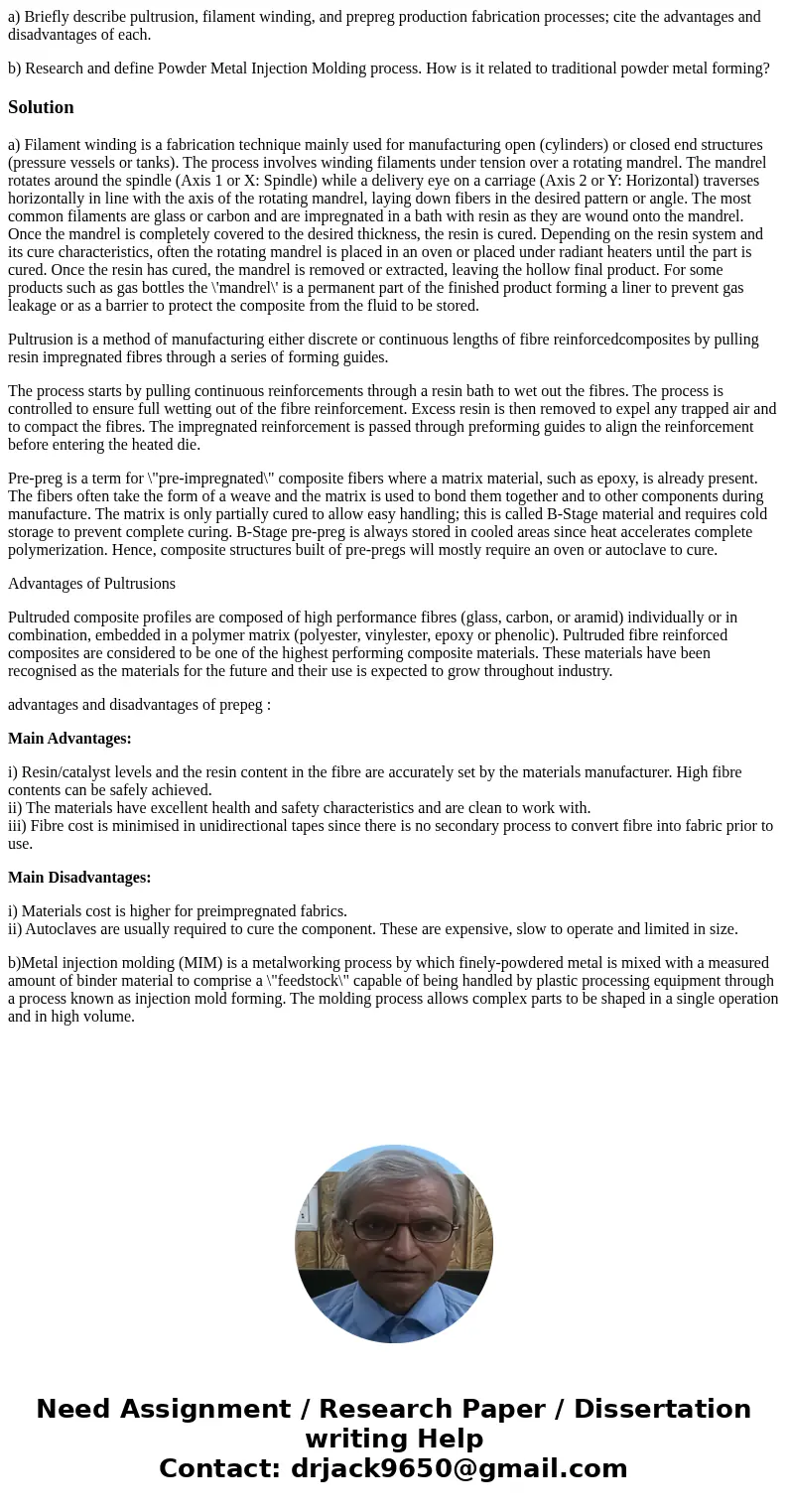a Briefly describe pultrusion filament winding and prepreg p
a) Briefly describe pultrusion, filament winding, and prepreg production fabrication processes; cite the advantages and disadvantages of each.
b) Research and define Powder Metal Injection Molding process. How is it related to traditional powder metal forming?
Solution
a) Filament winding is a fabrication technique mainly used for manufacturing open (cylinders) or closed end structures (pressure vessels or tanks). The process involves winding filaments under tension over a rotating mandrel. The mandrel rotates around the spindle (Axis 1 or X: Spindle) while a delivery eye on a carriage (Axis 2 or Y: Horizontal) traverses horizontally in line with the axis of the rotating mandrel, laying down fibers in the desired pattern or angle. The most common filaments are glass or carbon and are impregnated in a bath with resin as they are wound onto the mandrel. Once the mandrel is completely covered to the desired thickness, the resin is cured. Depending on the resin system and its cure characteristics, often the rotating mandrel is placed in an oven or placed under radiant heaters until the part is cured. Once the resin has cured, the mandrel is removed or extracted, leaving the hollow final product. For some products such as gas bottles the \'mandrel\' is a permanent part of the finished product forming a liner to prevent gas leakage or as a barrier to protect the composite from the fluid to be stored.
Pultrusion is a method of manufacturing either discrete or continuous lengths of fibre reinforcedcomposites by pulling resin impregnated fibres through a series of forming guides.
The process starts by pulling continuous reinforcements through a resin bath to wet out the fibres. The process is controlled to ensure full wetting out of the fibre reinforcement. Excess resin is then removed to expel any trapped air and to compact the fibres. The impregnated reinforcement is passed through preforming guides to align the reinforcement before entering the heated die.
Pre-preg is a term for \"pre-impregnated\" composite fibers where a matrix material, such as epoxy, is already present. The fibers often take the form of a weave and the matrix is used to bond them together and to other components during manufacture. The matrix is only partially cured to allow easy handling; this is called B-Stage material and requires cold storage to prevent complete curing. B-Stage pre-preg is always stored in cooled areas since heat accelerates complete polymerization. Hence, composite structures built of pre-pregs will mostly require an oven or autoclave to cure.
Advantages of Pultrusions
Pultruded composite profiles are composed of high performance fibres (glass, carbon, or aramid) individually or in combination, embedded in a polymer matrix (polyester, vinylester, epoxy or phenolic). Pultruded fibre reinforced composites are considered to be one of the highest performing composite materials. These materials have been recognised as the materials for the future and their use is expected to grow throughout industry.
advantages and disadvantages of prepeg :
Main Advantages:
i) Resin/catalyst levels and the resin content in the fibre are accurately set by the materials manufacturer. High fibre contents can be safely achieved.
ii) The materials have excellent health and safety characteristics and are clean to work with.
iii) Fibre cost is minimised in unidirectional tapes since there is no secondary process to convert fibre into fabric prior to use.
Main Disadvantages:
i) Materials cost is higher for preimpregnated fabrics.
ii) Autoclaves are usually required to cure the component. These are expensive, slow to operate and limited in size.
b)Metal injection molding (MIM) is a metalworking process by which finely-powdered metal is mixed with a measured amount of binder material to comprise a \"feedstock\" capable of being handled by plastic processing equipment through a process known as injection mold forming. The molding process allows complex parts to be shaped in a single operation and in high volume.

 Homework Sourse
Homework Sourse